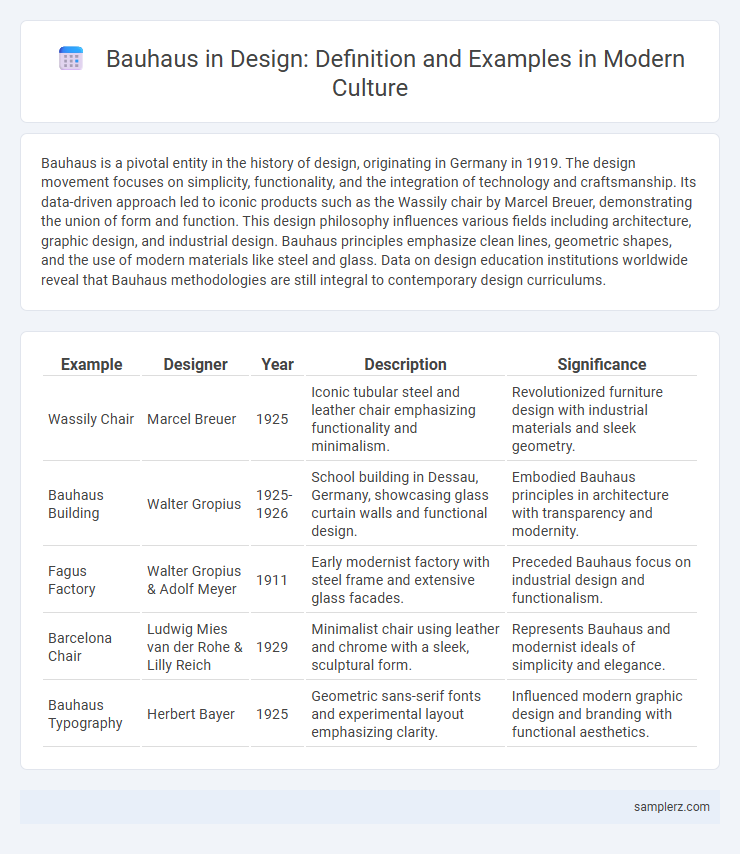Bauhaus is a pivotal entity in the history of design, originating in Germany in 1919. The design movement focuses on simplicity, functionality, and the integration of technology and craftsmanship. Its data-driven approach led to iconic products such as the Wassily chair by Marcel Breuer, demonstrating the union of form and function. This design philosophy influences various fields including architecture, graphic design, and industrial design. Bauhaus principles emphasize clean lines, geometric shapes, and the use of modern materials like steel and glass. Data on design education institutions worldwide reveal that Bauhaus methodologies are still integral to contemporary design curriculums.
Table of Comparison
| Example | Designer | Year | Description | Significance |
|---|---|---|---|---|
| Wassily Chair | Marcel Breuer | 1925 | Iconic tubular steel and leather chair emphasizing functionality and minimalism. | Revolutionized furniture design with industrial materials and sleek geometry. |
| Bauhaus Building | Walter Gropius | 1925-1926 | School building in Dessau, Germany, showcasing glass curtain walls and functional design. | Embodied Bauhaus principles in architecture with transparency and modernity. |
| Fagus Factory | Walter Gropius & Adolf Meyer | 1911 | Early modernist factory with steel frame and extensive glass facades. | Preceded Bauhaus focus on industrial design and functionalism. |
| Barcelona Chair | Ludwig Mies van der Rohe & Lilly Reich | 1929 | Minimalist chair using leather and chrome with a sleek, sculptural form. | Represents Bauhaus and modernist ideals of simplicity and elegance. |
| Bauhaus Typography | Herbert Bayer | 1925 | Geometric sans-serif fonts and experimental layout emphasizing clarity. | Influenced modern graphic design and branding with functional aesthetics. |
Origins of Bauhaus: Defining a Design Revolution
Bauhaus emerged in 1919 in Weimar, Germany, founded by architect Walter Gropius, marking a pivotal shift in design philosophy by merging craftsmanship with industrial techniques. This revolutionary school emphasized functionality, simplicity, and the integration of art, architecture, and technology, influencing modernist design globally. Its origins reflect a response to post-World War I social and economic changes, aiming to democratize design and unify artistic disciplines.
Key Principles of Bauhaus Design Aesthetics
Bauhaus design aesthetics emphasize simplicity, functionality, and the integration of art with technology. Key principles include the use of geometric shapes, minimal ornamentation, and a focus on materials and craftsmanship. This approach revolutionized modern design by promoting harmony between form and function, influencing architecture, graphic design, and industrial design globally.
Iconic Bauhaus Furniture: Timeless Classics
Iconic Bauhaus furniture pieces like the Wassily Chair by Marcel Breuer and the Barcelona Chair by Ludwig Mies van der Rohe exemplify the movement's emphasis on functional simplicity and innovative materials. These timeless classics showcase clean lines, tubular steel frames, and minimalistic design principles that revolutionized 20th-century modern design. Their enduring appeal lies in the perfect balance between form and function, influencing contemporary furniture design worldwide.
Bauhaus Influence on Modern Architecture
Bauhaus principles revolutionized modern architecture by emphasizing functional design, simplicity, and the use of industrial materials such as steel and glass. Iconic buildings like the Bauhaus Dessau school showcase clean lines and geometric forms that have influenced countless architects worldwide. This movement bridged art and technology, promoting an aesthetic that prioritizes utility and innovation in urban planning and residential construction.
Notable Bauhaus Designers and Their Contributions
Walter Gropius revolutionized modern design by founding the Bauhaus School, emphasizing functionality and simplicity in architecture. Marcel Breuer introduced innovative tubular steel furniture, blending industrial materials with sleek aesthetics. Ludwig Mies van der Rohe advanced minimalist principles, creating iconic structures that embody Bauhaus ideals of form following function.
Bauhaus in Graphic Design: A Visual Language
Bauhaus revolutionized graphic design by introducing a visual language centered on simplicity, geometric shapes, and functional typography, which emphasized clarity and communication. The movement's use of grid systems and sans-serif fonts created a standardized, modern aesthetic influencing contemporary branding and advertising. Its principles fostered a universal design approach that balances form and function, shaping visual culture worldwide.
Color Theory and Materials in Bauhaus Creations
Bauhaus design emphasizes the use of primary colors--red, blue, and yellow--applied in pure, geometric forms to achieve visual harmony and balance. Materials such as steel, glass, and concrete are integrated seamlessly to reflect functionality and modernity, embodying the movement's philosophy of combining aesthetics with industrial techniques. This fusion of color theory and innovative materials results in iconic Bauhaus creations that continue to influence contemporary design principles.
Bauhaus Legacy in Contemporary Product Design
Bauhaus principles of simplicity, functionality, and geometric forms continue to influence contemporary product design, shaping minimalist aesthetics and ergonomic functionality. Iconic Bauhaus elements such as clean lines, primary colors, and innovative use of materials are evident in modern household gadgets, furniture, and consumer electronics. The legacy of Bauhaus endures in design education and practice, driving sustainable innovation and user-centered design trends worldwide.
Global Spread of Bauhaus Ideals
Bauhaus design principles, characterized by minimalism, functionalism, and the integration of art and technology, have influenced architectural and design movements worldwide. Institutions in the United States, Israel, and Mexico adapted Bauhaus methods, leading to the emergence of modernist styles in urban planning and product design. Its global legacy persists in contemporary education, emphasizing interdisciplinary collaboration and simplicity in form and function.
Everyday Life: Bauhaus Design in Daily Objects
Bauhaus design revolutionized everyday life by integrating functionality with minimalist aesthetics in daily objects such as kitchenware, furniture, and household tools. Iconic pieces like Marianne Brandt's metal teapots and Marcel Breuer's tubular steel chairs exemplify the movement's emphasis on simple forms, practicality, and mass production. This approach transformed mundane items into timeless designs that remain influential in contemporary interior and industrial design.

example of Bauhaus in design Infographic
 samplerz.com
samplerz.com